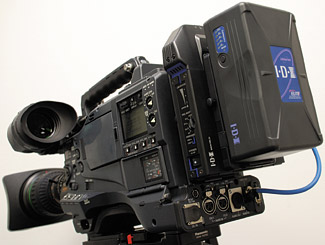IDX CW-5HD Cam-Wave System

The IDX CW-5HD wireless HD transmitter Any DP who has had clients or producers looking over his shoulder as he shoots, can readily appreciate being able to have them monitor the shoot unobtrusively and wirelessly. Until recently, that was difficult enough to do in SD, let alone in HD. However, thanks to some new wireless standards, MIMO (multiple input, multiple output) technology and OFDM (orthogonal frequency division multiplexing) data modulation, that is precisely what IDX's Cam-Wave HD wireless video system is designed to do.
FEATURES
Cam-Wave HD (or CW5-HD for short) uses the same core components as a wireless audio system—a transmitter and a receiver—to operate in license-free spectrum. The transmitter is linked to a camera and the receiver is typically connected to a monitor, or possibly to a video recorder. CW5-HD is a completely uncompressed wireless system that supports both SD and HD SDI video, as well as two channels of SDI embedded audio. Moreover, it supports multiple streams of video, and can handle multiple formats, including 1080i/23.98Psf. Its signal latency is rated at less than 1 ms, or effectively no noticeable latency.
CW5-HD uses IEEE 802.11 standards for wireless local area network (WLAN) computer communications in the 5 GHz and 2.4 GHz public spectrum bands. However, it uses the latest versions of that standard to achieve the high data rates needed for multiple streams of HD video. This maximum raw data rate supported is 54 Mbps.
The system also uses the proposed 802.11n standard which adds MIMO OFDM and other new features for a maximum raw data rate of 300 Mbps. Moreover, it achieves a minimum effective operating range of up to 150 feet, line-of-sight.
The transmitter and receiver are both fairly lightweight, less than two pounds each. The transmitter mounts to the camera via a standard V-lock, or Anton/Bauer mount, and includes an identical mount for the respective battery, which powers both transmitter and camera. The same is true for the receiver, which has the same form factor and looks quite similar to some IDX chargers. Each unit draws only 12 watts when operational.
The transmitter includes a five-position frequency selector dial with channels 1-4 and auto select, plus a uni/multichannel option switch. There is also a high/ low power mode switch, plus an LED status indicator. On the opposite side of the transmitter is an HD-SDI input and an HD-SDI output, plus a standard four-pin 12 VDC power plug. The receiver has the same form factor and uni/multichannel switch, but no channel selector. It senses whatever signal is sent. It features two HD SDI output connections. Both units are finished in slate black and trimmed with IDX's signature shades of violet and blue.
IN USE
The Cam-Wave HD system arrived in an official IDX kit carrying bag with lots of side pockets for batteries and cables, and a sturdy strap. Inside was a complete package for operating the system with any HD SDI camera or camcorder. The system also includes the TX CW-5HD transmitter, the RX CW-5HD receiver, BNC cables, several 55 watt Endura 7 batteries, dual-channel IDX charger, plus a 7-inch Nebtek 70 HDS monitor in a sturdy dual-handle frame for easy handholding. The kit also included an IDX 14.4 power adaptor with a V-lock mount for use with a Canon XL series camcorder. This enabled a Canon XL H1 camcorder to be used for this evaluation. The CW5-HD set can also be used with any pro camcorders equipped with HD SDI.
After connecting the transmitter to the camcorder and the receiver to the Nebtek monitor, I fired everything up only to get a "no-signal" error display in the monitor. After several attempts at troubleshooting, I called in for technical support. This confirmed that all of the settings on the transmitter were correct and also for the receiver. I finally got wise and decided to swap out the Nebtek monitor for a multistandard 8-inch unit I had. Sure enough, as soon as I made the substitution I got a good HD signal. Problem solved.
No further adjustment was necessary, as the HD signal transmission was flawless and quite impressive. I could now test the system's performance.
My first test was fairly basic, and done inside my home. I turned the camcorder on and framed a scene at the very front end of the house. I then took the monitor and receiver to the far end, about 75 feet away with three sturdy walls in between. Even though there was some distortion and signal breakup while I was walking, the signal was crisp and rock steady once I stopped. This continued as I stepped outside and traveled another 20 feet or so. Again there was some minor breakup while I was moving, but that vanished when I stopped. However, as soon as I descended a stairway that put me some five or six feet below my "line-of-sight" to the camcorder, the signal broke up and then vanished altogether. Apparently, the issue was not distance between transmitter and receiver, but rather dropping below the signal path.
After moving the camcorder and transmitter within line-of-sight of the driveway through a glass-paneled storm door, I next took the monitor and receiver for a walk down the driveway. As I continued down the driveway some young evergreen trees and a pickup truck got in the signal path, but did not critically impede the signal. In fact, I managed to walk at least 150 feet before I lost it. However, there was some breakup and signal deterioration just past the halfway mark. On my next attempt I moved the transmitter slightly to improve the line-of-sight, while following the same route down the driveway. This extended the CW5-HD's range by another 20 to 30 feet.
Then I brought the camcorder and transmitter unit outside and placed them about five feet above ground, and in line with the driveway. Again I made the walk down the driveway with the receiver and monitor in hand. This time I was able to make 170 feet before the digital dropouts really increased. However, the signal remained usable, especially so when I paused and aimed the monitor/receiver directly at the transmitter. I finally lost the HD signal at about 240 feet, some 90 feet past the unit's stated maximum range of 150 line-of-sight.
As encouraging as the 240 foot distance was, I couldn't help but wonder if it could be improved if all obstacles were removed from the signal path. To test this, I mounted the camcorder and Cam-Wave transmitter on a tripod at the sidewalk end of the driveway and began pacing down the sidewalk with the receiver and monitor. The signal remained strong and clear again for at least 240 feet, but got a bit noisy after that. The dropouts abated if I paused momentarily. I finally stopped at nearly 300 feet from the transmitter, to see if I could still receive a completely clean image at that distance. To my surprise, about 90 percent of the dropouts did clear up, leaving a slightly noisy, but very viewable image. I resumed walking slowly and noticed that the dropouts began to reappear incrementally beyond 310 feet. Still, the system kept a picture of sorts up all the way out to about 340 feet.

To see if these results were really valid, I did one more test in an area with a completely clear line-of-sight. This time I started backing away from the transmitter, and stopped just before the 300 foot mark to see if the slowly increasing digital breakup would subside. This time I was able to maintain a viewable HD image until the system crashed just past 360 feet. This confirmed that—although there's no guarantee—it could be possible to use CW-5HD to monitor a camera's activity, from the length of a football field, at least under ideal conditions.
It's worth noting that I did not have an opportunity to check the HD signals on a waveform monitor to determine at what point they were and were not technically valid. A brief discussion with IDX experts suggested that when the equipment is used within the stated range of 100 feet with obstacles, and 150 feet without obstacles, proper signals are available for critical applications. The IDX sources cautioned that the Cam-Wave HD package is not designed for transmitting a "legally" recordable HD signal, but that it is often used for that purpose.
SUMMARY
IDX's Cam-Wave offers a simple, effective way to monitor, transmit or record HD and SD camera images remotely and wirelessly. It leaves the cameraperson unimpeded by entangling cables. By combining new WLAN standards, data modulation and recent advances in antenna technology, Cam-Wave can achieve data rates greater than 1.243 Gbps, without compression. This enables the wireless transmission of a sharp high-definition video signal with embedded SDI audio with very minimal latency.
Transmission distances are impressive and the system supports multiple SD and HD video formats including 1080i/23.98Psf.
The CW-5HD's uses could include remote news, field production video assist, telemedicine applications, video relay in large theaters, arenas, sports stadiums, training facilities and other such venues. It could also be used with special effects cameras or lipstick cameras for transmitting signals to a remotely located recorder for risky special effects locations/applications or for surveillance purposes.
Carl Mrozek operates Eagle Eye Media, based in Bufallo, N.Y., which specializes in wildlife and outdoor subjects. His work regularly appears onthe Discovey Channel, The Weather Channel, CBS, PBS and other networks. He may be contacted ateagleye11@gmail.com.
The professional video industry's #1 source for news, trends and product and tech information. Sign up below.
